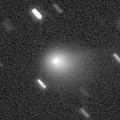
|
Now it is so bright as 9.3 mag (Oct. 5, Juan Jose Gonzalez). It will be unobservable soon. In the Southern Hemisphere, it will appear in the morning sky at 9 mag in 2013 February, then it keeps observable in good condition while fading slowly. In the Northern Hemisphere, it is hardly observable after 2013.
Date(TT) R.A. (2000) Decl. Delta r Elong. m1 Best Time(A, h)
Oct. 27 15 55.88 -5 1.1 2.861 2.039 28 9.7 19:56 ( 82, -2)
Nov. 3 16 8.18 -7 45.5 2.864 2.002 24 9.6 20:05 ( 76, -5)
|
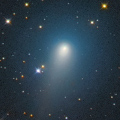
|
It brightened very rapidly. Now it is very bright visually as 9.5 mag (Oct. 18, Marco Goiato). It approaches to the earth down to 0.4 A.U., and it is observable in good condition in September and October. The nuclear split was observed in late October.
Date(TT) R.A. (2000) Decl. Delta r Elong. m1 Best Time(A, h)
Oct. 27 23 41.26 34 20.3 0.529 1.443 140 10.0 21:16 (180, 20)
Nov. 3 23 39.68 36 33.2 0.574 1.460 135 10.5 20:47 (180, 18)
|
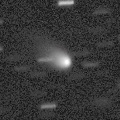
|
It is expected to be a great comet of -1 mag in 2013 spring. Now it is 10.1 mag (Oct. 14, Marco Goiato). Brightening faster than originally expected. It will be unobservable soon in the Southern Hemisphere. In the Northern Hemisphere, it keeps unobservable for a long time until 2013 March, when the comet will appear as a 0-mag great comet.
Date(TT) R.A. (2000) Decl. Delta r Elong. m1 Best Time(A, h)
Oct. 27 15 32.23 -29 22.5 3.473 2.616 25 10.9 19:56 ( 59, 8)
Nov. 3 15 39.41 -30 8.4 3.414 2.516 21 10.7 20:05 ( 55, 3)
|
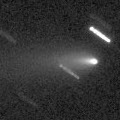
|
Now it is bright at 11.1 mag (Oct. 13, Carlos Labordena). It is expected to approach to the earth and to be observable at 8 mag in good condition in winter. The condition is good in the Northern Hemisphere. It turns to be in the morning sky after November, and will be getting higher rapidly. In the Southern Hemisphere, it is not observable now. But it will become observable in good condition after 2013 January.
Date(TT) R.A. (2000) Decl. Delta r Elong. m1 Best Time(A, h)
Oct. 27 14 30.30 40 40.2 1.554 1.255 53 11.7 19:56 (116,-42)
Nov. 3 14 27.43 40 54.6 1.447 1.214 55 11.4 3:22 (245,-46)
|

|
Now it is bright as 11.4 mag (Oct. 15, Chris Wyatt). It is expected to be observable at 11-13 mag for a long time from 2012 summer to 2013 summer. It is not observable until 2013 January in the Northern Hemisphere. In the Southern Hemisphere, it will be extremely low from October to December.
Date(TT) R.A. (2000) Decl. Delta r Elong. m1 Best Time(A, h)
Oct. 27 14 47.18 -47 5.9 2.811 2.081 35 11.9 19:56 ( 40, 12)
Nov. 3 14 58.37 -45 18.9 2.877 2.087 30 12.0 20:05 ( 38, 7)
|
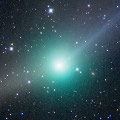
|
It kept as bright as 6-7 mag for a long time from 2011 summer to 2012 spring. Now it is fading. But it is very bright as 12.8 mag still now (Oct. 20, Katsumi Yoshimoto).
Date(TT) R.A. (2000) Decl. Delta r Elong. m1 Best Time(A, h)
Oct. 27 10 7.85 -1 37.8 4.441 4.038 60 12.8 3:32 (256, 22)
Nov. 3 10 7.78 -2 40.9 4.397 4.104 66 12.9 3:22 (253, 27)
|

|
It brightened up to 11-12 mag in 2012. Now it is not observable. But it will be observable at 12-13 mag in good condition again in 2013.
Date(TT) R.A. (2000) Decl. Delta r Elong. m1 Best Time(A, h)
Oct. 27 15 21.32 -14 50.8 6.271 5.337 18 13.4 19:56 ( 69, -3)
Nov. 3 15 22.90 -15 7.3 6.318 5.352 11 13.4 20:05 ( 64,-10)
|
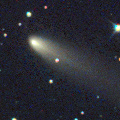
|
First return of a new periodic comet which brightened up to 14 mag in 2005. It brightened very rapidly and became much brighter than originally expected. Now it is very bright as 12.2 mag (Oct. 9, Uwe Pilz). It keeps observable in excellent condition at 11-13 mag from summer to autumn.
Date(TT) R.A. (2000) Decl. Delta r Elong. m1 Best Time(A, h)
Oct. 27 1 41.08 41 25.7 0.627 1.572 150 13.4 23:15 (180, 13)
Nov. 3 1 35.69 42 17.8 0.657 1.596 150 13.7 22:43 (180, 13)
|
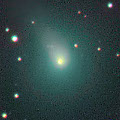
|
It brightened much faster than expected. Now it is so bright as 11.5 mag (Sept. 15, Seiichi Yoshida). In the Northern Hemisphere, it keeps observable at 11-13 mag in good condition until early 2013. In the Southern Hemisphere, it is not observable until late 2012.
Date(TT) R.A. (2000) Decl. Delta r Elong. m1 Best Time(A, h)
Oct. 27 10 6.89 30 12.2 2.535 2.417 71 13.4 3:32 (231, 2)
Nov. 3 10 4.05 28 49.6 2.453 2.455 78 13.5 3:22 (228, 6)
|
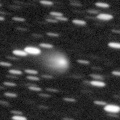
|
Now it is 13.3 mag (Sept. 13, Jakub Cerny). It keeps bright at 13-14 mag for a long time until 2014. It keeps observable for a long time in the Northern Hemisphere. It is not observable in the Southern Hemisphere.
Date(TT) R.A. (2000) Decl. Delta r Elong. m1 Best Time(A, h)
Oct. 27 20 42.69 43 52.0 5.737 6.076 105 13.5 19:56 (162, 8)
Nov. 3 20 40.46 42 15.7 5.791 6.064 101 13.6 20:05 (155, 7)
|
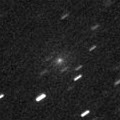
|
The nuclear magnitude got fainter than 19 mag in August, and no observations have been reported since September. Although it was expected to be 13 mag in 2012 autumn, the comet must have been already disintegrated and disappeared.
Date(TT) R.A. (2000) Decl. Delta r Elong. m1 Best Time(A, h)
Oct. 27 17 18.14 -17 41.8 1.846 1.366 46 13.7 19:56 ( 83, 22)
Nov. 3 17 45.42 -19 58.5 1.899 1.403 45 13.9 20:05 ( 80, 21)
|
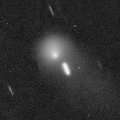
|
Now it is bright as 13.1 mag (Sept. 22, Jakub Cerny). It keeps bright as 13-14 mag for a long time after this until 2013. It is not observable in the Northern Hemisphere, but it is observable in good condition in the Southern Hemisphere.
Date(TT) R.A. (2000) Decl. Delta r Elong. m1 Best Time(A, h)
Oct. 27 4 18.33 -57 43.9 5.554 5.881 104 13.8 1:57 ( 0, 67)
Nov. 3 4 9.08 -57 37.6 5.570 5.900 104 13.9 1:20 ( 0, 67)
|

|
Now it is bright and visible visually at 12.8 mag (Oct. 5, Juan Jose Gonzalez). It keeps observable in good condition at 13-14 mag for a long time until winter. It locates somewhat low in the Southern Hemisphere.
Date(TT) R.A. (2000) Decl. Delta r Elong. m1 Best Time(A, h)
Oct. 27 23 39.94 32 15.2 2.347 3.184 141 13.9 21:15 (180, 23)
Nov. 3 23 41.18 30 38.4 2.372 3.176 137 13.9 20:49 (180, 24)
|

|
It brightened rapidly, and reached up to 12 mag in 2012. It is not observable now. But it will be observable at 12-14 mag in good condition again in 2013. However, it locates somewhat low in the Northern Hemisphere in 2013.
Date(TT) R.A. (2000) Decl. Delta r Elong. m1 Best Time(A, h)
Oct. 27 15 13.21 -12 41.8 3.864 2.924 16 14.1 19:56 ( 70, -6)
Nov. 3 15 24.28 -13 45.2 3.879 2.917 12 14.1 20:05 ( 65,-10)
|

|
Big asteroid discovered in 1906. It suddenly showed the cometary activity on Dec. 11, 2010, probably due to an impact of a small object. Now it is 11.9 mag (May 29, Marco Goiato). It has already turned to be stellar.
Date(TT) R.A. (2000) Decl. Delta r Elong. m1 Best Time(A, h)
Oct. 27 17 59.94 -31 23.8 2.953 2.545 56 14.2 19:56 ( 74, 36)
Nov. 3 18 13.27 -31 28.4 3.032 2.553 52 14.3 20:05 ( 72, 32)
|
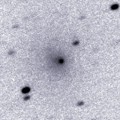
|
Not observable now. It will appear in the morning sky in late November.
Date(TT) R.A. (2000) Decl. Delta r Elong. m1 Best Time(A, h)
Oct. 27 13 19.17 -16 36.5 7.213 6.244 12 14.3 3:32 (296, -7)
Nov. 3 13 24.19 -17 8.8 7.187 6.243 16 14.2 3:22 (294, -4)
|
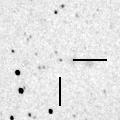
|
Appearing in the morning sky. Now it is 15.3 mag, much brighter than origianlly predicted (Oct. 14, Hidetaka Sato). It is expected to brighten up to 5-6 mag in 2013 spring. In the Southern Hemisphere, it keeps observable while brightening gradually after this in good condition. In the Northern Hemisphere, it is only observable until early January when it becomes 10 mag. After 2013 May, it keeps observable in good condition while fading gradually.
Date(TT) R.A. (2000) Decl. Delta r Elong. m1 Best Time(A, h)
Oct. 27 11 10.71 -3 5.7 3.163 2.550 44 15.1 3:32 (266, 11)
Nov. 3 11 16.89 -5 6.3 2.989 2.460 49 14.7 3:22 (266, 14)
|
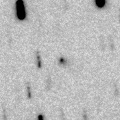
|
Now it is 15.9 mag (Oct. 13, Toshiyuki Takahashi). It is expected to brighten up to 10 mag from winter to spring in 2013. In the Northern Hemisphere, it keeps observable in good condition until 2013 April. It is not observable now in the Southern Hemisphere. It will become observable after 2013 April, but it keeps locating low.
Date(TT) R.A. (2000) Decl. Delta r Elong. m1 Best Time(A, h)
Oct. 27 18 12.86 84 38.2 2.583 2.927 100 15.2 19:56 (174,-32)
Nov. 3 18 48.87 83 44.0 2.479 2.858 102 15.0 20:05 (173,-32)
|
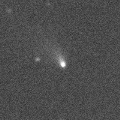
|
Now it is 15.7 mag (Oct. 7, V. Gerke, A. Novichonok, S. Plaksa). It will brighten up to 15 mag from autum to winter. In the Northern Hemisphere, it keeps observable for a long time until the comet fades out. It is not observable in the Southern Hemisphere, except for 2013 spring, but the comet locates extremely low only.
Date(TT) R.A. (2000) Decl. Delta r Elong. m1 Best Time(A, h)
Oct. 27 13 44.62 68 28.9 2.297 2.361 81 15.5 3:32 (206,-42)
Nov. 3 13 48.48 69 31.7 2.208 2.340 84 15.4 3:22 (205,-41)
|
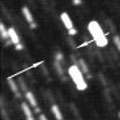
|
Now it is 14.9 mag (Sept. 14, Jakub Cerny). In the Southern Hemisphere, it will be observable at 15-16 mag in good condition for a long time until 2013 summer. It is not observable at all in the Northern Hemisphere.
Date(TT) R.A. (2000) Decl. Delta r Elong. m1 Best Time(A, h)
Oct. 27 18 0.44 -80 44.2 4.120 3.937 72 15.5 19:56 ( 11, 39)
Nov. 3 18 29.65 -80 43.6 4.169 3.947 70 15.6 20:05 ( 11, 38)
|
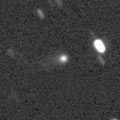
|
Now it is 15.7 mag (Sept. 25, Hiroshi Abe)�$B!#�(BIt keeps 15-16 mag from autumn to winter. It keeps observable in good condition for a long time until the comet fades out in the Northern Hemisphere. It is not observable until 2013 summer in the Southern Hemisphere. By the way, Juan Jose Gonzalez reported it extremely bright as 10.7 mag visually on Sept. 6.
Date(TT) R.A. (2000) Decl. Delta r Elong. m1 Best Time(A, h)
Oct. 27 10 15.35 77 28.2 3.295 3.538 95 15.6 3:32 (193,-29)
Nov. 3 10 13.17 80 25.3 3.214 3.538 100 15.6 3:22 (190,-30)
|

|
It kept as bright as 11-12 mag for a long time from 2011 autumn to 2012 spring. Now it is 16.4 mag (Sept. 25, Hiroshi Abe). It keeps observable in good condition until next spring while the comet will be fading gradually.
Date(TT) R.A. (2000) Decl. Delta r Elong. m1 Best Time(A, h)
Oct. 27 10 5.85 5 50.9 3.273 2.950 62 15.7 3:32 (249, 18)
Nov. 3 10 12.71 5 3.9 3.215 2.982 67 15.8 3:22 (248, 21)
|
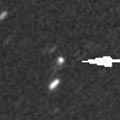
|
It is expected to keep 13 mag and observable in good condition in the Northern Hemisphere for a long time from 2013 to 2014. Now it is 15.8 mag (Oct. 19, Hiroshi Abe). It keeps unobservable until late November in the Southern Hemisphere.
Date(TT) R.A. (2000) Decl. Delta r Elong. m1 Best Time(A, h)
Oct. 27 11 20.17 17 5.3 5.680 5.110 50 15.9 3:32 (251, -3)
Nov. 3 11 23.21 17 34.5 5.536 5.067 57 15.8 3:22 (249, -1)
|
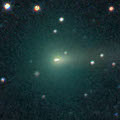
|
It brightened rapidly, and reached up to 10 mag from July to August. Now it is fading. But it is bright as 13.6 mag still now (Oct. 16, Gerke, A. Novichonok, S. Plaksa). It keeps observable in the morning sky after this.
Date(TT) R.A. (2000) Decl. Delta r Elong. m1 Best Time(A, h)
Oct. 27 10 6.12 -1 18.6 1.586 1.397 60 15.8 3:32 (255, 23)
Nov. 3 10 18.53 -3 9.7 1.599 1.463 63 16.4 3:22 (256, 25)
|
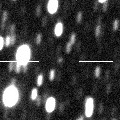
|
First return of a new periodic comet discovered in 1994. Now it is 17.0 mag (Yasukazu Ikari). It was expected to brighten rapidly, to reach up to 13.5 mag, and to be observable in good condition from autumn to winter. But actually, it is much fainter than this ephemeris. It will be 15-16 mag at best.
Date(TT) R.A. (2000) Decl. Delta r Elong. m1 Best Time(A, h)
Oct. 27 20 18.45 12 41.7 0.868 1.383 95 16.1 19:56 (143, 34)
Nov. 3 20 38.48 9 51.8 0.854 1.350 93 16.0 20:05 (137, 35)
|
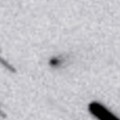
|
New comet. Now it is 17.5 mag (Oct. 17, A. Knoefel). It approaches to the Sun down to 0.3 A.U. in 2013 February. The ephemeris says it will brighten up to 7 mag. However, because the comet is small, it may be disintegrated. It keeps observable in good condition until February while brightening gradually.
Date(TT) R.A. (2000) Decl. Delta r Elong. m1 Best Time(A, h)
Oct. 27 4 2.81 18 51.4 1.472 2.392 151 17.1 1:42 (180, 36)
Nov. 3 3 50.57 16 26.5 1.326 2.288 161 16.7 1:02 (180, 38)
|

|
New asteroid with a very small perihelion distance of 0.38 A.U. Now it is 16.5 mag (Oct. 24, Yasukazu Ikari). It will be observable at 17 mag in excellent condition from mid October to mid November in the Northern Hemisphere. It locates extremely low in the Southern Hemisphere.
Date(TT) R.A. (2000) Decl. Delta r Elong. m1 Best Time(A, h)
Oct. 27 18 25.44 23 13.6 0.437 0.961 72 16.9 19:56 (128, 10)
Nov. 3 19 27.63 29 40.8 0.558 1.084 83 17.1 20:05 (137, 9)
|
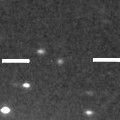
|
It is expected to be a great comet in 2013 autumn when the comet approaches to the sun down to only 0.01 A.U. It keeps visible with naked eyes from November to January, and can be extremely bright as Venus or more at the highlight. Now it is 17.2 mag (Oct. 12, A. Knoefel). The condition is excellent in the Northern Hemisphere. It keeps observable almost all through the period of brightening, at the highlight, and of fading. The condition is not good in the Southern Hemisphere. It is not observable at all the latter part of the highlight, and it keeps low all through the period. The orbit is similar to that of Comet Kirch in 1680.
Date(TT) R.A. (2000) Decl. Delta r Elong. m1 Best Time(A, h)
Oct. 27 8 21.39 28 1.2 5.810 5.940 92 17.1 3:32 (214, 18)
Nov. 3 8 21.47 28 10.1 5.622 5.870 99 16.9 3:22 (210, 20)
|
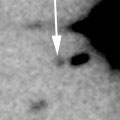
|
Now it is 17.2 mag (Sept. 29, K. Hills). In the Southern Hemisphere, it keeps observable at 17 mag in good condition for a long time from 2012 to 2013. It is not observable at all in the Northern Hemisphere.
Date(TT) R.A. (2000) Decl. Delta r Elong. m1 Best Time(A, h)
Oct. 27 6 59.57 -66 24.9 4.891 4.901 84 17.3 3:32 (348, 57)
Nov. 3 6 50.43 -68 33.4 4.880 4.893 84 17.3 3:22 (354, 56)
|
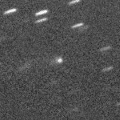
|
Now it is 17.4 mag (Oct. 4, Catalina Sky Survey). It keeps 17 mag for a long time from 2009 to 2013.
Date(TT) R.A. (2000) Decl. Delta r Elong. m1 Best Time(A, h)
Oct. 27 22 21.77 8 33.8 7.976 8.582 124 17.3 19:57 (180, 46)
Nov. 3 22 18.90 8 4.0 8.094 8.597 117 17.4 20:05 (166, 46)
|
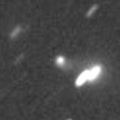
|
Jakub Cerny reported the comet brightened up to 14.5 mag in late July. However, it has already faded down to 16.7 mag (Oct. 5, F. G. Pinilla). It will be observable in good condition in the Southern Hemisphere while fading gradually after this. It will locate somewhat low in the Northern Hemisphere.
Date(TT) R.A. (2000) Decl. Delta r Elong. m1 Best Time(A, h)
Oct. 27 22 45.04 -29 32.8 3.542 4.072 115 17.4 20:20 (180, 84)
Nov. 3 22 46.05 -29 13.0 3.688 4.127 109 17.6 20:05 (157, 84)
|
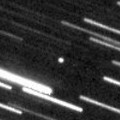
|
Now it is 17.4 mag (Sept. 29, Jean-Francois Soulier). In the Northern Hemisphere, it will be observable at 17.5 mag in excellent condition in October and November. It locates low in the Southern Hemisphere.
Date(TT) R.A. (2000) Decl. Delta r Elong. m1 Best Time(A, h)
Oct. 27 2 25.28 43 13.2 1.325 2.238 149 17.4 0:05 (180, 12)
Nov. 3 2 5.08 41 27.8 1.336 2.265 152 17.4 23:11 (180, 14)
|

|
Now it is 20.5 mag (Sept. 17, O. Burhonov, A. Novichonok). It will brighten very rapidly, and will reach up to 13 mag from winter to spring. In the Northern Hemisphere, it keeps observable in excellent condition. In the Southern Hemisphere, it keeps locating extremely low for a while.
Date(TT) R.A. (2000) Decl. Delta r Elong. m1 Best Time(A, h)
Oct. 27 9 8.24 37 38.8 2.380 2.513 85 17.9 3:32 (217, 5)
Nov. 3 9 20.32 37 23.7 2.264 2.474 90 17.6 3:22 (216, 5)
|
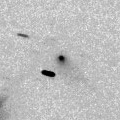
|
First return of a new periodic comet discovered in 2005. Now it is 16.9 mag (Oct. 6, J. F. Hernandez). It will be observable in excellent condition at 17-18 mag until November.
Date(TT) R.A. (2000) Decl. Delta r Elong. m1 Best Time(A, h)
Oct. 27 23 2.00 3 56.4 1.389 2.196 133 17.6 20:37 (180, 51)
Nov. 3 23 4.32 3 54.8 1.453 2.202 127 17.7 20:12 (180, 51)
|
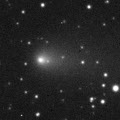
|
It brightened up to 12 mag in 2010. Now the comet is around the aphelion. But it will be observable at 17.5 mag in good condition from autumn to winter. Now it is 19.4 mag (Oct. 9, Mt. Lemmon Survey), fainter than this ephemeris.
Date(TT) R.A. (2000) Decl. Delta r Elong. m1 Best Time(A, h)
Oct. 27 4 36.71 20 58.5 3.768 4.603 143 17.6 2:15 (180, 34)
Nov. 3 4 32.89 20 57.7 3.718 4.611 151 17.6 1:44 (180, 34)
|
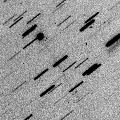
|
Looks almost asteroidal. But it has a very faint tail. It passed near by the earth, and brightened up to 13.9 mag (July 22, Artyom Novichonok). Now it is fading, but still bright as 16.7 mag (Oct. 6, J. F. Hernandez). It keeps observable in excellent condition in the Northern Hemisphere. It is not observable in the Southern Hemisphere.
Date(TT) R.A. (2000) Decl. Delta r Elong. m1 Best Time(A, h)
Oct. 27 18 4.75 36 9.8 2.231 2.186 74 17.6 19:56 (133, -3)
Nov. 3 18 10.46 36 7.7 2.344 2.252 72 17.8 20:05 (129, -7)
|
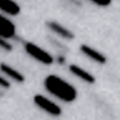
|
Now it is 17.4 mag (Sept. 29, A. Diepvens). It keeps 17-18 mag for a long time until the end of 2013. The condition is good in the Northern Hemisphere. It is hardly observable in 2012 in the Northern Hemisphere. But it will be observable in good condition in 2013.
Date(TT) R.A. (2000) Decl. Delta r Elong. m1 Best Time(A, h)
Oct. 27 23 59.99 53 50.1 4.013 4.736 131 17.8 21:34 (180, 1)
Nov. 3 23 50.30 51 39.1 4.002 4.714 131 17.7 20:57 (180, 3)
|
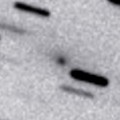
|
The condition of this apparition is bad, and it was not observable around the perihelion passage. Now it is 16.5 mag (Oct. 6, Catalina Sky Survey). It will be fainter than 18 mag soon.
Date(TT) R.A. (2000) Decl. Delta r Elong. m1 Best Time(A, h)
Oct. 27 1 23.70 -0 2.2 2.019 2.985 163 17.8 22:58 (180, 55)
Nov. 3 1 17.94 -0 11.1 2.087 3.020 155 17.9 22:25 (180, 55)
|
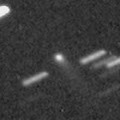
|
Although it was extremely faint as 20.0 mag on May 27 (Hidetaka Sato), it brightened rapidly and reached up to 16.8 mag (Sept. 25, K. Hills). Now it is fading, but it is bright as 17.2 mag still now (Oct. 19, Yasukazu Ikari). However, it will be fainter than 18 mag soon.
Date(TT) R.A. (2000) Decl. Delta r Elong. m1 Best Time(A, h)
Oct. 27 22 58.04 10 21.4 1.275 2.091 133 17.8 20:33 (180, 45)
Nov. 3 22 59.38 10 54.5 1.341 2.100 127 18.0 20:07 (180, 44)
|

|
New comet. Now it is 17.3 mag (Oct. 13, R. H. McNaught). But it will be fainter than 18 mag soon. It locates very low in the Northern Hemisphere.
Date(TT) R.A. (2000) Decl. Delta r Elong. m1 Best Time(A, h)
Oct. 27 19 56.91 -39 38.9 1.881 1.971 80 17.8 19:56 ( 70, 61)
Nov. 3 20 16.46 -39 14.7 1.948 1.982 77 17.9 20:05 ( 70, 58)
|
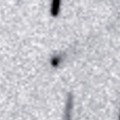
|
New comet. Now it is 17.5 mag (Oct. 17, Hidetaka Sato). But it will be fainter than 18 mag soon.
Date(TT) R.A. (2000) Decl. Delta r Elong. m1 Best Time(A, h)
Oct. 27 5 12.18 -21 4.0 1.237 1.966 123 17.9 2:50 (180, 76)
Nov. 3 5 13.00 -23 37.6 1.261 2.003 125 18.0 2:24 (180, 79)
|

|
This comet brightened up to 10 mag in outburst in 1995, however, it became lost after that. The condition of this apparition is bad. It was not observable around the perihelion passage. It is not detected, fainter than 19.0 mag (Sept. 16, Martin Masek).
Date(TT) R.A. (2000) Decl. Delta r Elong. m1 Best Time(A, h)
Oct. 27 8 12.66 6 48.0 2.327 2.530 89 17.9 3:32 (225, 37)
Nov. 3 8 15.89 6 18.0 2.285 2.582 95 18.2 3:22 (222, 39)
|
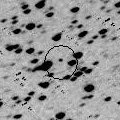
|
Peculiar asteroid moving along a cometary orbit. It keeps observable at 18 mag for a long time from 2008 to 2014.
Date(TT) R.A. (2000) Decl. Delta r Elong. m1 Best Time(A, h)
Oct. 27 8 9.73 31 54.8 6.844 7.018 95 18.0 3:32 (210, 16)
Nov. 3 8 8.98 32 36.1 6.738 7.029 103 17.9 3:22 (206, 17)
|
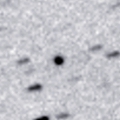
|
Jean-Francois Soulier reported that it had faded down to 19.8 mag on Sept. 16, however, it suddenly brightened up to 16.6 mag on Sept. 20. It brightened by about 3 mag in outburst. It became brighter furthermore, up to 15.9 mag, on Sept. 22 (Jakub Cerny). However, it is fading very rapidly after that. It has already faded down to 19.3 mag (Oct. 19, Yasukazu Ikari). It keeps observable in excellent condition after this in the Northern Hemisphere. It locates somewhat low in the Southern Hemisphere.
Date(TT) R.A. (2000) Decl. Delta r Elong. m1 Best Time(A, h)
Oct. 27 2 15.47 27 21.3 2.147 3.119 165 19.1 23:50 (180, 28)
Nov. 3 2 8.60 26 46.0 2.182 3.157 166 19.6 23:15 (180, 28)
|

|
First return of a new periodic comet discovered in 1997 at 17 mag. Now it is 19.2 mag (Sept. 25, Mt. Lemmon Survey). It was expected to keep 17 mag for a long time from 2012 to 2014. But actually, it is fainter than predicted by 2 mag.
Date(TT) R.A. (2000) Decl. Delta r Elong. m1 Best Time(A, h)
Oct. 27 2 7.78 13 41.7 2.932 3.925 179 19.2 23:42 (180, 41)
Nov. 3 2 4.06 13 17.8 2.923 3.909 172 19.2 23:11 (180, 42)
|
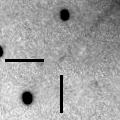
|
It was observed at 17 mag in 2011 autumn. It was expected to be observable at 17 mag in good condition again from autumn to winter in 2012. But actually, the comet is 19.4 mag (Sept. 29, G. Hug), much fainter than this ephemeris. Hidetaka Sato reported that it was not detected, fainter than 21.0 mag (Sept. 21). The comet must have faded out very rapidly.
Date(TT) R.A. (2000) Decl. Delta r Elong. m1 Best Time(A, h)
Oct. 27 6 48.87 27 56.0 2.539 3.065 112 20.3 3:32 (194, 26)
Nov. 3 6 49.82 29 12.1 2.470 3.084 119 20.3 3:22 (189, 25)
|
|
![]()
 C/2012 S1 ( ISON )
C/2012 S1 ( ISON ) C/2012 C1 ( McNaught )
C/2012 C1 ( McNaught ) C/2008 S3 ( Boattini )
C/2008 S3 ( Boattini ) C/2011 A3 ( Gibbs )
C/2011 A3 ( Gibbs ) (3200) Phaethon
(3200) Phaethon 63P/Wild 1
63P/Wild 1 261P/2012 K4 ( Larson )
261P/2012 K4 ( Larson ) 65P/Gunn
65P/Gunn P/2012 NJ ( La Sagra )
P/2012 NJ ( La Sagra ) C/2012 S4 ( PanSTARRS )
C/2012 S4 ( PanSTARRS ) 71P/Clark
71P/Clark 160P/LINEAR
160P/LINEAR C/2012 T4 ( McNaught )
C/2012 T4 ( McNaught ) C/2012 T6 ( Kowalski )
C/2012 T6 ( Kowalski ) 58P/Jackson-Neujmin
58P/Jackson-Neujmin 2008 YB3
2008 YB3 37P/Forbes
37P/Forbes 270P/2012 S5 ( Gehrels )
270P/2012 S5 ( Gehrels ) P/2011 N1 ( ASH )
P/2011 N1 ( ASH )![]()








































